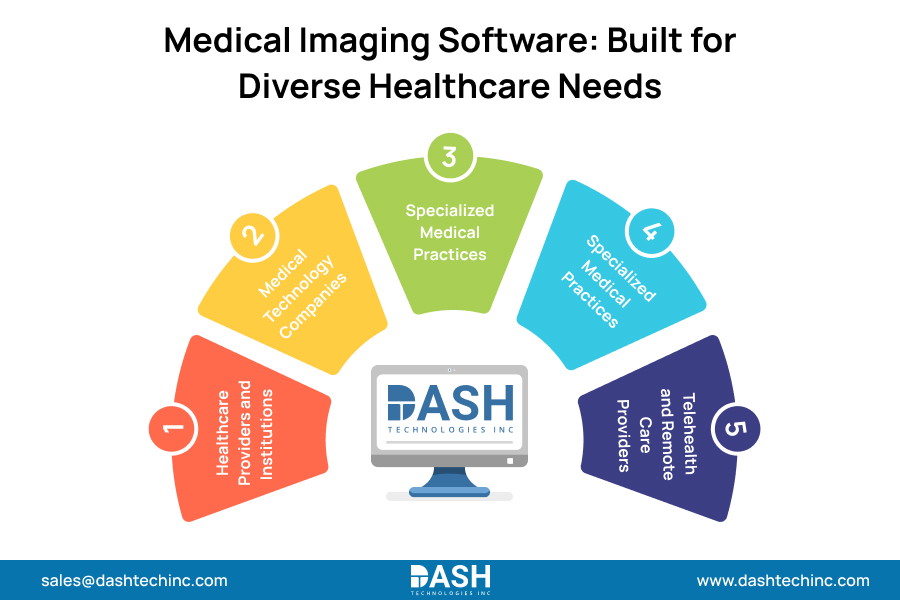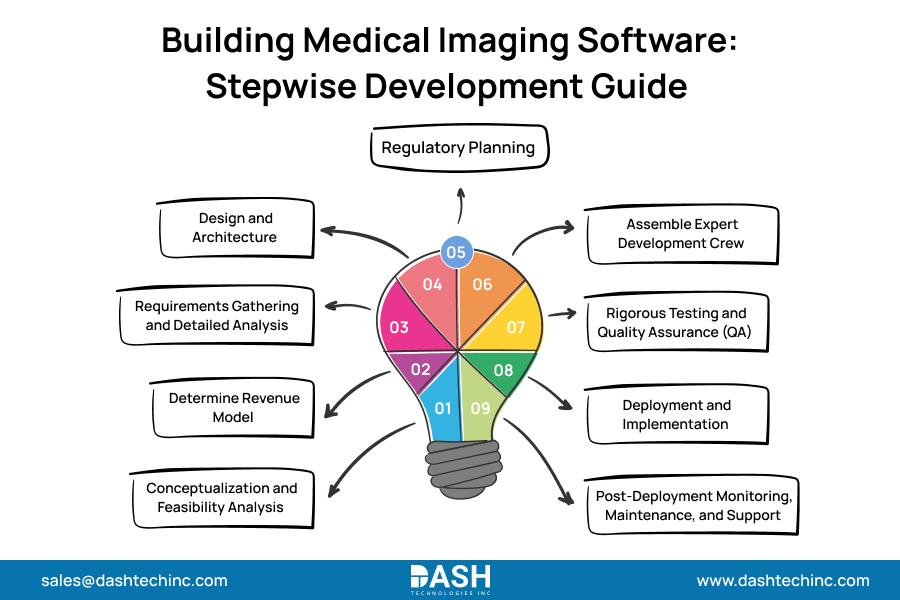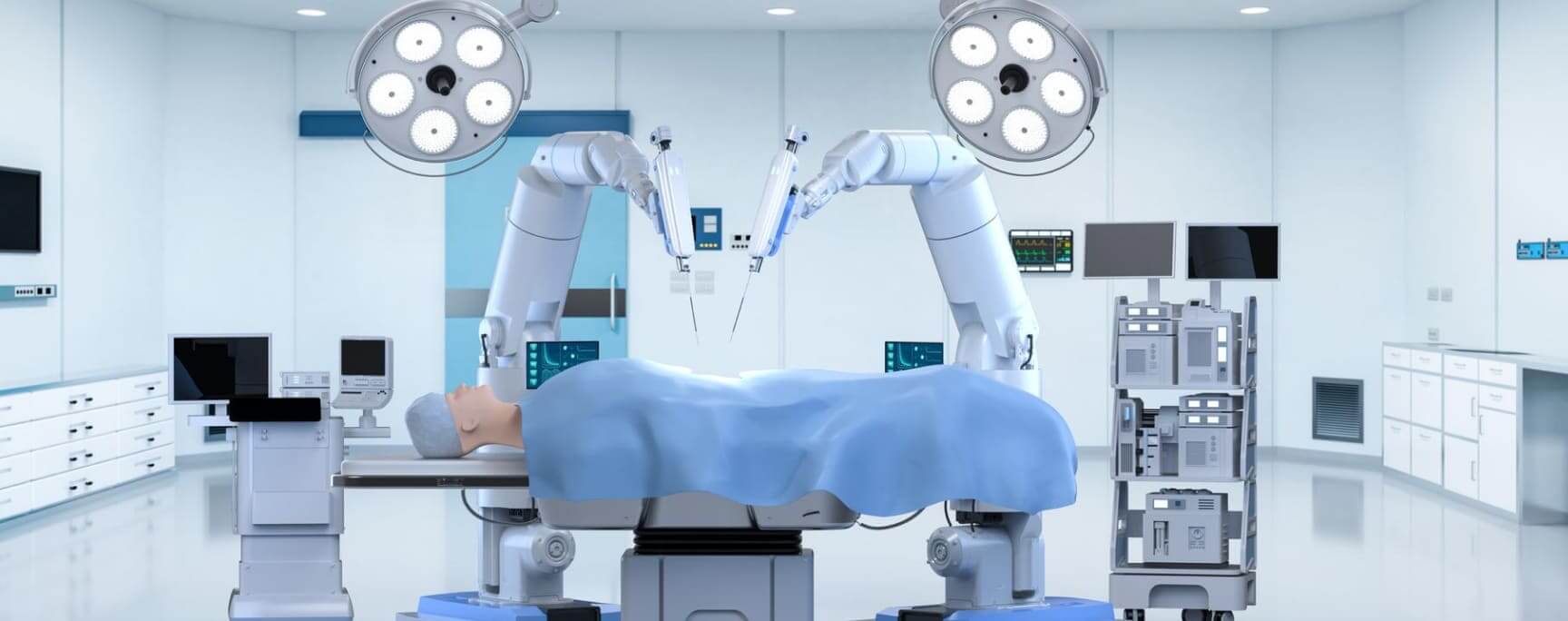Medical Imaging Software Development: Step-by-Step Process
Medical imaging software development is undoubtedly a fundamental component in modern healthcare—providing advanced tools that improve diagnostic precision, streamline treatment planning, and enhance patient outcomes. With AI integration, these tools and solutions are transforming providers’ decision-making abilities and accelerating care delivery.
What Is Medical Imaging Software?
Medical imaging software consists of specialized programs that enable the processing and analysis of medical images from X-rays to CT scans, MRIs, and ultrasounds. Advanced algorithms and image processing techniques used by these tools improve image quality, which helps healthcare professionals make accurate interpretations for informed diagnostic decisions.
Hospitals and clinics use this software in imaging facilities and research centers. This software helps them capture, store, analyze and share medical data. It commonly works together with PACS medical imaging systems for effective data management.
PACS in Medical Imaging Software
The Picture Archiving and Communication System (PACS) serves as a vital part of medical imaging software by offering cost-effective storage solutions and easy access to images from various imaging modalities, including X-ray, CT scans, MRI scans, and ultrasounds. The PACS implementation eliminates the requirement for physical storage by allowing digital distribution of images and reports, leading to better efficiency and accessibility.
Components of PACS
PACS comprises four main components:
- Imaging Modalities: Devices like X-ray machines, CT scanners, MRI machines, & ultrasound machines that generate medical images.
- Secured Network: A network protects patient information as it gets transmitted securely.
- Workstations: Healthcare professionals rely on computers for reading medical images.
- Archives: Archives enable the storage and retrieval of medical images and reports.
Who Needs Medical Imaging Software Development?

Healthcare Providers and Institutions
Advanced imaging software helps hospitals, imaging centers, and clinics improve diagnostic functions while optimizing operational processes. Medical imaging specialists and radiologists require advanced visualization tools that integrate smoothly with their existing PACS systems and electronic health records.
Medical Technology Companies
Medtech companies that create imaging hardware need corresponding software solutions to utilize their devices’ functionality fully. These companies require medical imaging software development partners who possess expertise in medical imaging technology while also understanding clinical end-user needs.
Research and Academic Institutions
Medical researchers and academic centers require flexible imaging platforms that aid clinical trials, enable the development of new diagnostic methods, and validate new treatment approaches. These institutions drive medical imaging technology forward by implementing pioneering applications.
Specialized Medical Practices
Orthopedics, neurology, oncology, and cardiology specialty practices require specific imaging software solutions to meet their unique diagnostic needs. Specialized medical professionals require tools that solve specific clinical problems yet remain compatible with larger healthcare infrastructure systems.
Telehealth and Remote Care Providers
As telehealth services grow, providers conducting remote consultations require secure methods for image sharing and collaborative analysis, along with integration of telehealth platforms. Diagnostic quality should remain intact when solutions provide accessible care that protects patient privacy.
A Step-by-Step Guide to Medical Imaging Software Development

Step 1. Conceptualization and Feasibility Analysis
The journey begins with a clear vision. This initial phase involves:
- Defining Scope & Objectives: Clearly identify what the program is all about, target users (e.g., radiologists, oncologists, orthopedic surgeons), and the issues it’s seeking to address.
- Market Research: Assessing the demand for the proposed software, analyzing competitor offerings, and identifying unique selling propositions.
- Feasibility Study: Examine whether the project meets technical requirements, provides economic benefits, and remains operationally viable. The preliminary assessment covers the necessary medical imaging technology and resources.
Step 2: Determine Revenue Model
- Subscription-Based: A recurring payment structure lets users maintain access to imaging software, making it ideal for cloud-based solutions that need regular updates & continuous support.
- Pay-Per-Use: Suitable for smaller clinics with fluctuating demands, charges based on usage volume, such the number of images processed.
- Licensing: Designed for companies seeking long-term value, a one-time charge for perpetual use.
- Commission-Based: Earns a percentage from transactions facilitated by the software, such as referrals or partnerships.
- Value-Based Pricing: Charges based on the value delivered, such as improved diagnostic accuracy or reduced operational costs.
Step 3. Requirements Gathering and Detailed Analysis
- Stakeholder Workshops: The process requires direct collaboration with clinicians, radiologists, IT administrators, and other users to establish detailed functional and non-functional needs.
- Technical Specifications: Defining performance benchmarks & data handling protocols while identifying desired system features includes image processing algorithms and AI-driven analytics.
- Integration Needs: It involves recognizing the requirements necessary to operate alongside existing hospital systems, including, Electronic Health Records (EHRs), and Radiology Information Systems (RIS).
Step 4. Design and Architecture
- System Architecture Design: The system architecture development phase establishes the software structure by detailing modules, components, databases, and their interactions. This phase considers scalability, security, and maintainability.
- User Interface (UI) and User Experience (UX) Design: The design of user interfaces focuses on simplicity and functionality to match medical professionals’ work.
- Technology Stack Selection: The development process requires selecting suitable programming languages and frameworks, such as those used in medical image deep learning, together with appropriate development tools.
Get Your Free eBook: Medical Imaging Innovation
A quick guide to smarter imaging solutions.
Access Now!Step 5. Regulatory Planning
- Identify applicable regulations (FDA, GDPR, HIPAA)
- Develop compliance documentation & risk management protocols
- Protect patient information through the implementation of data security measures
Step 6. Assemble Expert Development Crew
- Software Engineers: Proficiency in programming languages such as Python, Java, and C++ is critical for building reliable imaging software.
- Healthcare Specialists: Experts in medical imaging standards and DICOM technology maintain clinical application relevance.
- Regulatory Experts: Meeting HIPAA and GDPR requirements is essential for protecting patient data.
- Project Coordinators: Manage timelines, budgets, and team coordination for efficient project execution.
Collaborating with Dash Technologies enables streamlined processes through access to our skilled developers who focus on medical imaging software development. Successful product delivery depends on completing this important step.
Step 7. Rigorous Testing and Quality Assurance (QA)
- Unit and Integration Testing: Testing individual components and their integrations confirms proper functionality.
- System Testing: The complete system undergoes assessment to see if it meets all specified requirements.
- Performance Testing: The evaluation of the software must focus on its processing speed alongside stability and scalability capabilities when managing extensive image datasets.
- Security Testing: The process of discovering and fixing security weaknesses protects data integrity and maintains patient privacy.
Step 8. Deployment and Implementation
- Deployment Planning: Planning the rollout, potentially phased or going live in its entirety.
- Installation and Configuration: Installing software on hospital servers or cloud hosting & configuring to integrate with systems in place such as PACS medical imaging.
- Data Migration: If replacing an existing system, securely migrate stored patient imaging data.
- Training Users: Offering training for everyone involved, from doctors and technicians to admin staff.
Step 9. Post-Deployment Monitoring, Maintenance, and Support
- Performance Monitoring: It is essential to track the software’s performance as well as its uptime and usage patterns throughout its operation time.
- Regular Updates and Maintenance: Updates are released to address bugs and security vulnerabilities while enhancing features and boosting performance.
- Technical Support: Ongoing technical support for users solves their issues & answers their questions.
- Compliance Updates: The software must maintain compliance with the changing standards in medical imaging technology and healthcare regulations.
- Feedback Collection and Iteration: The software undergoes continuous improvement by incorporating user feedback into future enhancements and version updates.
Conclusion
Organizations that collaborate with seasoned developers familiar with technical demands and healthcare factors can establish solutions that address current needs while remaining adaptable to future advancements. Healthcare providers & their patients can realize substantial advantages through the strategic development of medical imaging software, encompassing system upgrades along with new capability implementations.
Dash Technologies stands at the forefront of this transformation by providing advanced AI medical imaging technology integration and solutions specifically designed for MedTech companies. Contact us today to learn about our support for your generative AI imaging solutions.
About Dash

Dash Technologies Inc.
We’re technology experts with a passion for bringing concepts to life. By leveraging a unique, consultative process and an agile development approach, we translate business challenges into technology solutions Get in touch.







